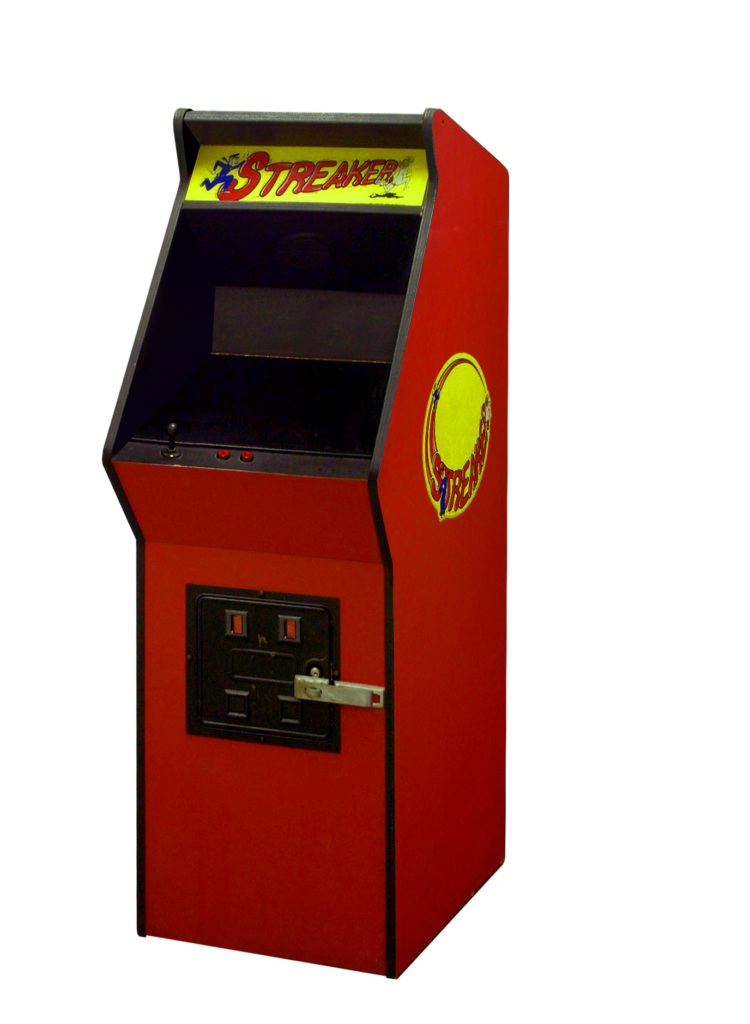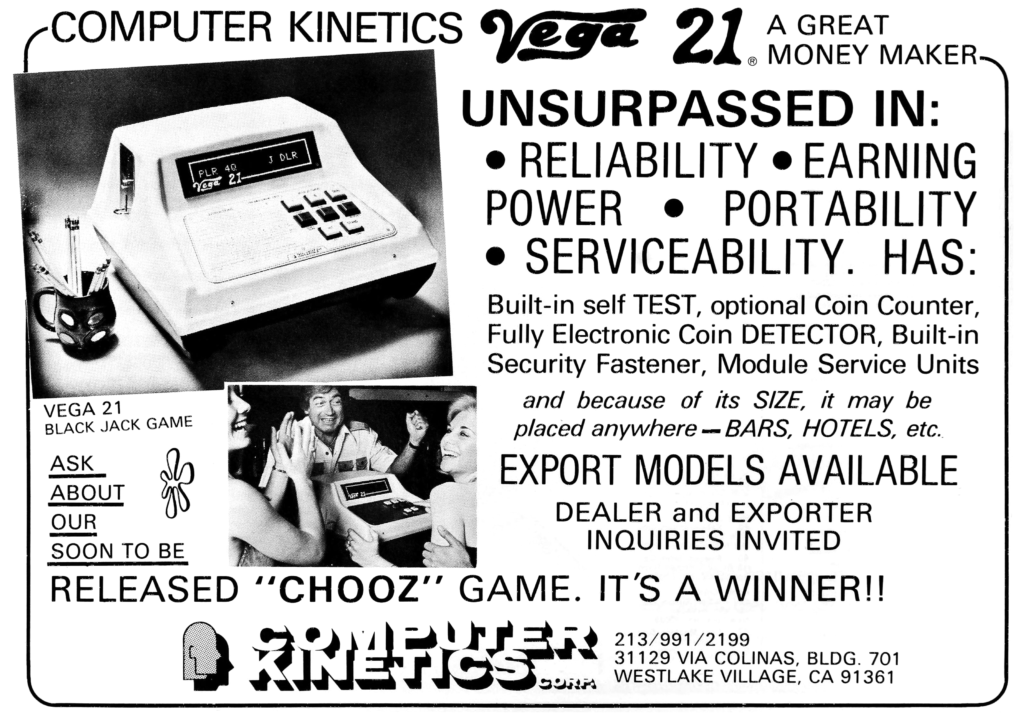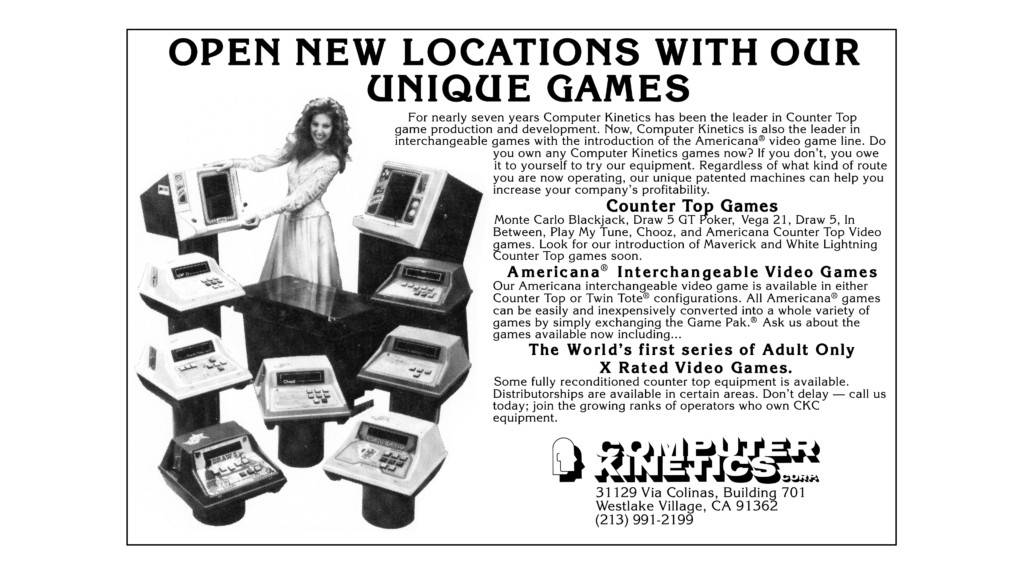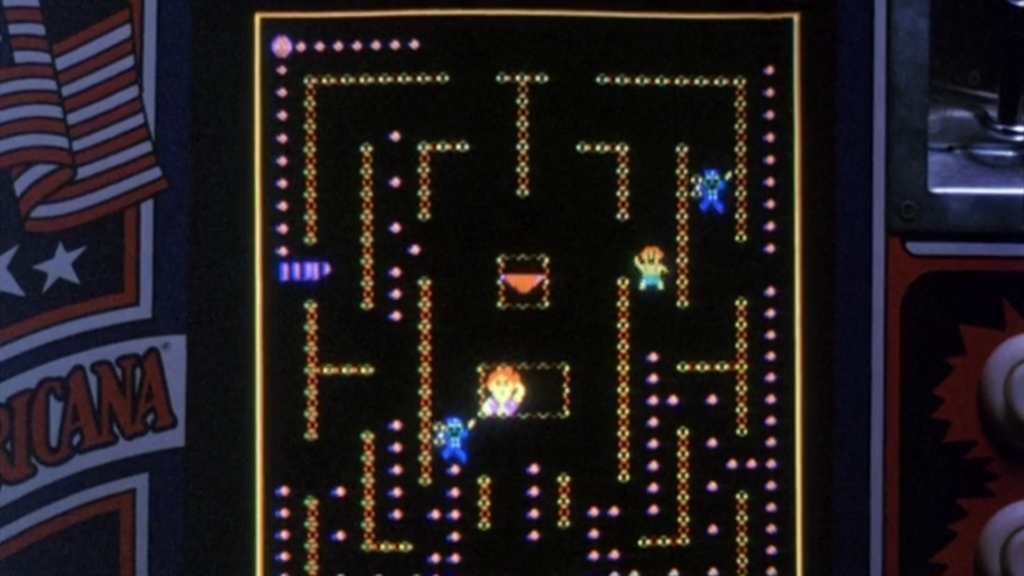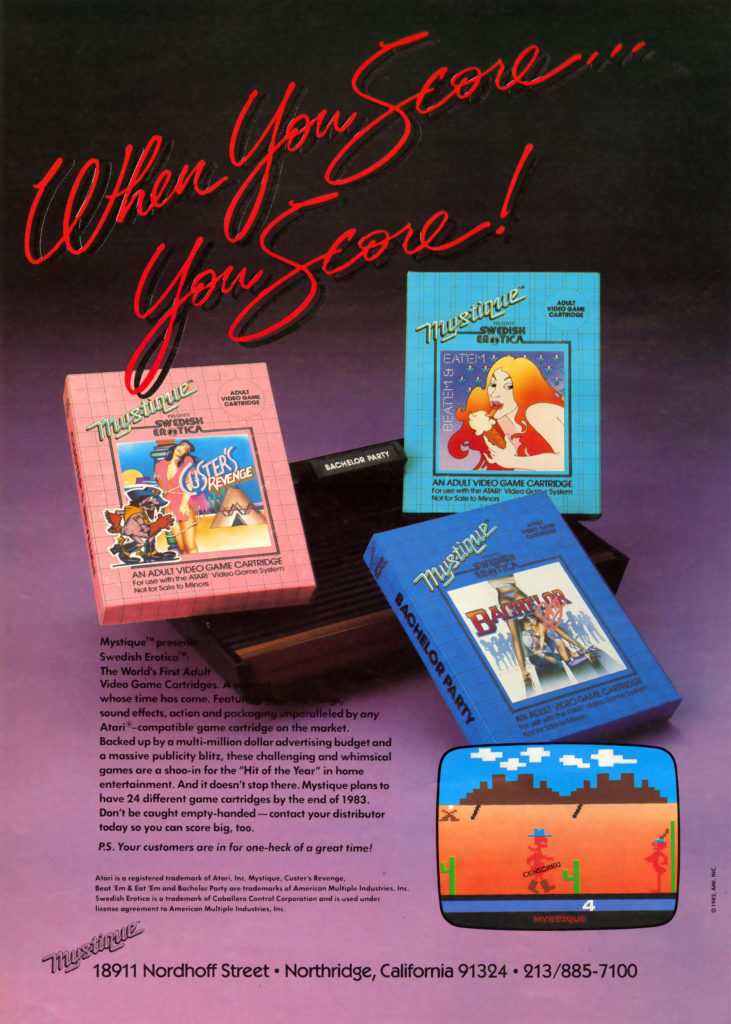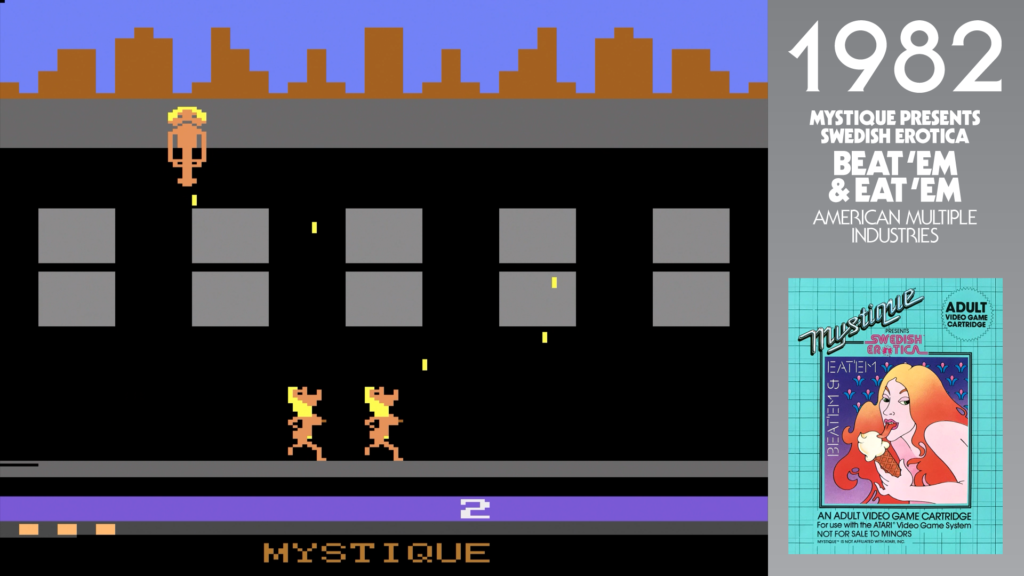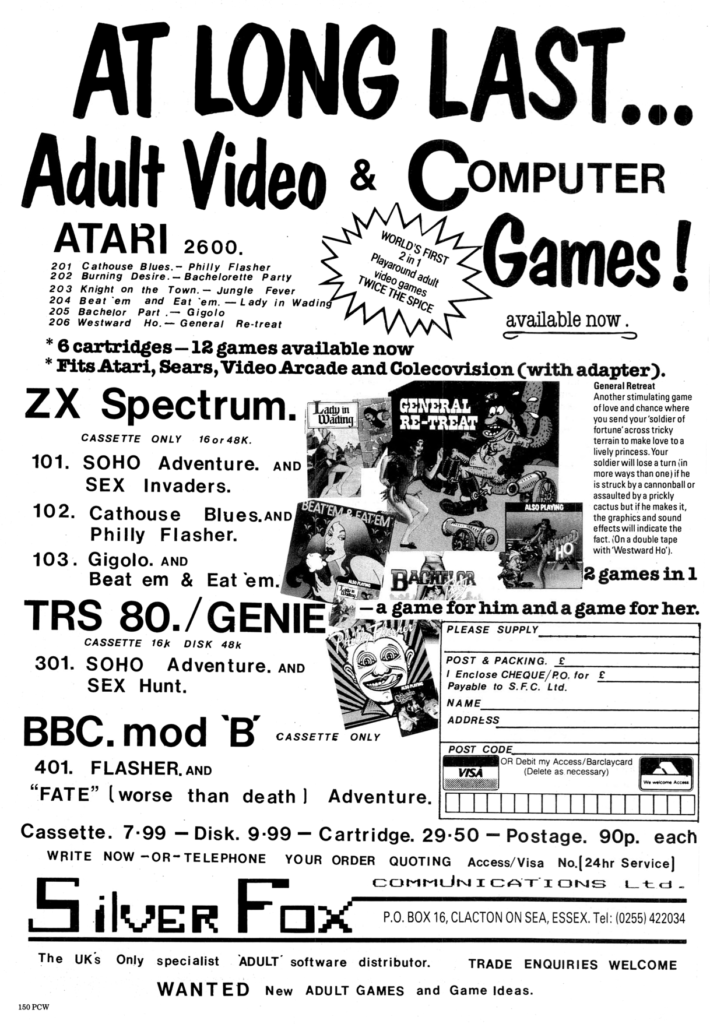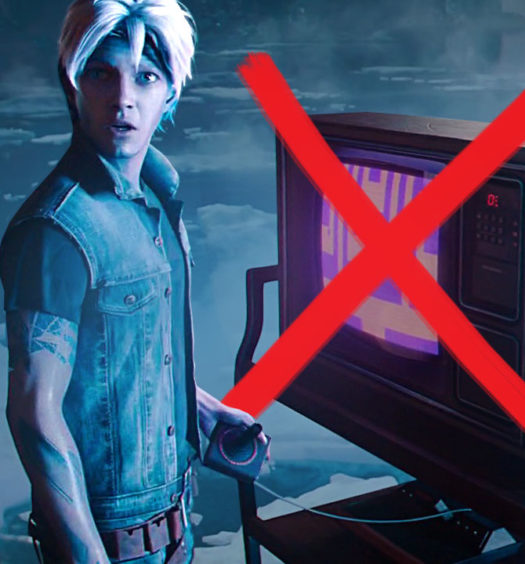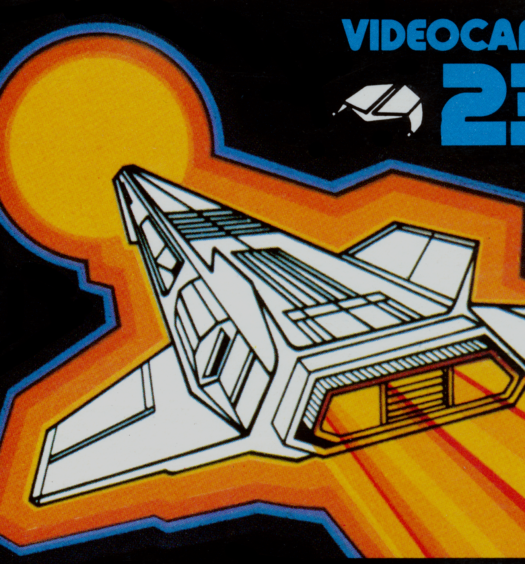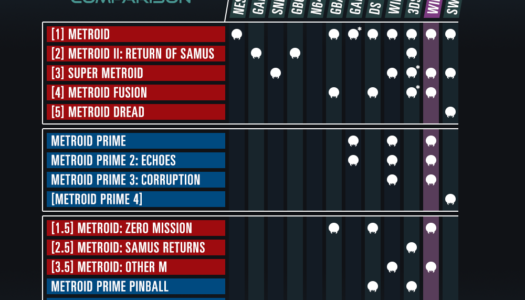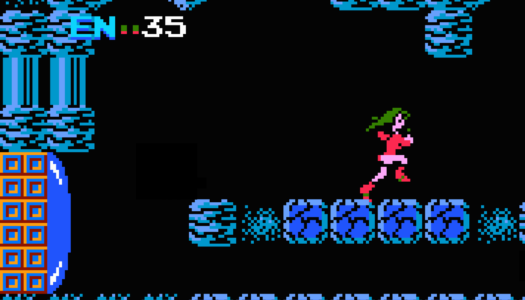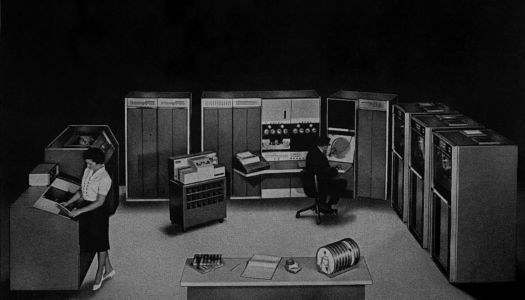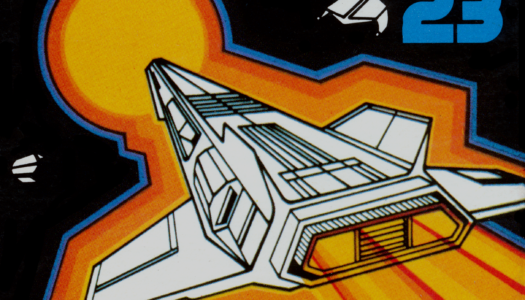Why The First Playable Women Of The ’80s Were Naked (Video Dames #0)
- What was the streaking fad of the ’70s?
- What was the first ’80 arcade game to feature a playable female character?
- What was Mystique Presents Swedish Erotica?
This is a transcript of the video above. The article version contains only a fraction of the visuals; I recommend watching the video for the full experience.
In 1974, streaking invaded campuses across the nation.
The press declared it an epidemic. A novelty song became a number one hit. The Academy Awards never saw it coming. And then it was over, as quickly as it began.
Like most fads, the streaking craze had a short lifespan but made a lasting impression. When score chasing became the first big craze of the ‘80s, coin-op magazine Play Meter declared it “1981’s answer to streaking.” So maybe it was only inevitable that someone would combine the two.
But why was the character a woman when streaking was done mostly by men? And why was this Japanese developer so interested in a dead American fad?
This is Video Dames: Episode Zero.
Running in the nude is a prank as old as time — or at the very least as old as nudity being a taboo. But the term “streaking” is relatively recent.
The earliest recorded use was in The Carletonian, the school newspaper of Carleton College in Northfield, Minnesota. Student journalists in 1967 saw no need to define the word, suggesting it was already in widespread use on campus.
By 1973, the term had spread to colleges across the country. When Time magazine claimed it was “a growing
Los Angeles-area fad,” a Carleton graduate took exception, explaining that the origin of the term came from it typically being done during Minnesota winters. If you didn’t remain a streak, you were liable to become a statue.
A Notre Dame graduate also wrote in, believing the practice had originated there. And while that’s certainly possible, the term wasn’t used in their school paper until 1969.
Women streaking was so rare that it instantly became news any time it happened. Time opened their Los Angeles report with a story about a streaking housewife. And when a woman at Carleton College volunteered to be interviewed about being the school’s first female streaker, it resulted in an Associated Press article distributed nationwide.
The more the news media reported on the streaking phenomenon, the faster it spread to other campuses. But when they declared it an epidemic, they never questioned their own culpability.
This all came to a head the first week of March, culminating in a nationwide streak held on Thursday, March 7th. Colleges competed with each other to set various records. The longest streak. The largest streak. The most witnessed streak.
The next week, enthusiastic exchange students imported streaking to Japan. Within days, locals began trying it out for
themselves. But Japan’s most infamous streaking incident occurred almost a decade after the craze was already dead.
On Sunday, March 8th, 1981, an unidentified woman ran through the streets of Harajuku, Tokyo wearing nothing but a cigarette. Onlookers cheered and handed her a beer. The police handed her a 20,000 yen fine. ($242 USD in 2021, adjusted for inflation.)
A photographer on the scene sold his photos to Weekly Shincho magazine, along with an account of the event. When word got out that the editors had forgotten to obscure the woman’s pubic hair, the issue sold out immediately.
It was only seven months later that a company called Shoei introduced an arcade game featuring a female streaker being chased by police.
I don’t think this was a coincidence.
Streaking (1981) By Shoei
Shoei was founded in 1966 by Kunisato Tada as an auto repair company before pivoting to video games by the end of 1975. But the change wasn’t out of an abundance of ideas. Most of Shoei’s output consisted of shameless
knock-offs of other company’s games, at a time when there were no laws against it.
Then, in April 1981, Midway filed a complaint against thirty-five different video game companies for copyright infringement of Namco’s Pac-Man. Shoei made the list thanks to a clone called Bite Monster.
But not all of Shoei’s games were unauthorized copies. A few years earlier they licensed a game called
S.O.S. Game from a developer called K.K. Tokki. The developer also licensed the game to Namco, but Shoei’s version was in color.
S.O.S. Game was notable for being Japan’s first “undressing” game, a trope that rewarded a players’ skill with a striptease. For every 2,000 points you earned, the game played an intermission called a “coffee brake” [sic] which displayed a pin-up of a reclining woman. At 6,000 points she took off her top, and if you reached 10,000 points she would be completely nude.
Arcade owners had the option to turn this off, but then Shoei introduced Streaking Japan’s first un-undressing game.
But was she actually nude? A closer look reveals that she appears to be wearing a skin-toned bikini with nipples drawn on, perhaps to get around the problem of full frontal nudity. This is less apparent in the MAME version, which does note that the colors may not be accurate. Although less colorful, this version does make her look less sunburnt.
The gameplay still borrows heavily from Pac-Man, but there are also a few key differences. In Pac-Man, your goal is to eat all the dots in the maze while evading the enemies. Each enemy has their own unique pattern, and they all periodically rotate between being passive and aggressive. Eating a large pellet gives you Popeye-esque superpowers, which allows you to eat ghosts. And fruit occasionally appears that you can eat for bonus points.
In Streaking, you’re still evading enemies in a maze while eating dots for some reason, but now you have a “Fatigue” meter. The “Fatigue” meter begins to fill any time you stop eating, and if it fills completely, you lose a life.
Some corridors have multiple rows, which is a little unsettling. Large pellets teleport you to the opposite corner of the maze, so you can temporarily escape your pursuers. And instead of fruit, you collect clothing.
You’d think the cops would stop chasing you once you’re fully dressed, but instead they start chasing you even harder.
Once you’ve collected the hat, the coat, and the umbrella, all that’s left for you to collect are bags of money. For some reason this transforms you into a magnificent cape-wearing supervillain, though it’s unclear whether the money is
being stolen from somewhere, or if it’s being sent to you by your adoring fans and patrons.
Streaking was released in Japan in October 1981, the same month Shoei brought it to Chicago to show to potential U.S. distributors at the AMOA trade show. Play Meter described it as “a cute idea, but someone should tell the Shoci [sic] designers that the streaking fad faded from the American scene several years ago.”
Ultimately, no respectable video game company was interested in distributing the game, perhaps realizing that female nudity would be a tough sell. However, it did catch the eye of a few smaller companies at the show, who were — shall we say — not as respectable.
Streaker (1981) By Computer Games Inc.
Computer Games Inc. was founded on August 13th, 1981 by Fred J. Alkire and Harvey J. Bowman, two entrepreneurs in the Birmingham, Alabama area. The company technically consisted of two separate companies created on the same day. Alkire registered Computer Games Inc. while Bowman registered Alabama Video Games Inc.
In theory, the two companies were intended to service slightly different aspects of the arcade video game market, but in practice the line got pretty blurry. Both men worked for both companies, and seemingly used the names interchangeably, if they used the original names at all.
One or both men were likely in attendance at AMOA in October, perhaps trying to promote a concept they called Chameleon, a cabinet intended to make conversion kits easier to install.
But the moment they saw Streaking, they must’ve dropped everything to rush a new, last-minute replacement ad to Replay magazine. Among their pick-ups was apparently the U.S. rights to Streaking, which they renamed Streaker. The next month they ran a revised ad that didn’t look like it was relayed over the phone to an annoyed production designer.
When Replay spoke to Harvey Bowman about the game in January, he claimed orders were “pouring in … from all over America just from word of mouth.” But he also claimed that the protagonist spoke, a feature that locals don’t remember at all.
Bhamwiki contributor Lee K. Seitz was a frequent visitor of the Patriot Arcade, located in the Birmingham suburb of Homewood. One day while he was there, he overheard the owner telling someone that he was the manufacturer of Streaker, which would certainly explain why the Patriot Arcade always had multiple Streaker cabinets sitting around unplayed.
The Patriot Arcade doubled as a show floor for the company, to demonstrate the machines to potential buyers. Locals recognized the name as a reference to the Homewood school mascot, the Patriot. In the second half of 1982, Computer Games Inc. began running dedicated Streaker ads in Play Meter, during which they even started calling themselves Patriot Games.
However, Alkire and Bowman sometimes made it sound like they were the creators of Streaker, not just its manufacturers. As Bowman told Replay magazine: “The last thing we would want to do would be to create a game that shows bad taste or vulgarity, thus offending the public.”
Two decades later he and his wife would be standing trial for running a prostitution ring out of the last strip club in Alabama while laundering the money through a restaurant and a day care center.
Streaker, on the other hand, never did see a public outcry. As the game’s supposed creator Fred Alkire explained to Video Games magazine: “She looks like Miss Piggy. You don’t even know she’s naked until she starts putting her clothes on. We’re located in one of the most Baptist sections of the country, and we haven’t received any complaints yet.”
It sounds like another tall tale, but Lee K. Seitz confirms for me that despite being prominently displayed, Streaker was pretty much ignored.
His mother, Pat Seitz — also an avid arcader — said she only tried Streaker “maybe once” and “thought it was odd, since real streakers I knew of were always men. I was so used to women being objectified and sexualized that it never occurred to me to object.”
Outside of regulars to the short-live Patriot Arcade, few people seem to remember Streaker, which suggests it never made it very far outside of Alabama. But Computer Games, Inc. wasn’t the only company who picked up the game.
Stripper (1982) By Computer Kinetics Corp.
Computer Kinetics Corp. was founded on October 19th, 1976 by Jack “Pat” Nelson and Rich Calverley, two electronics engineers in the Los Angeles area who teamed up to design countertop bar games.
Their first product was called Vega 21, a Blackjack simulator played on the friendly orange glow of a small plasma computer screen, which was successful enough that they developed an entire line of countertop bar games. Then, in the summer of 1982, they decided to branch out into video games.
Americana was designed as a countertop video arcade cabinet with a set of interchangeable games. But unlike Computer Games Inc.’s Chameleon, Americana’s games were sold as easy-to-insert “Game Paks,” spelled without the “c” years before Nintendo did it.
Americana’s launch ads were a little bit vague about just what games were available, but they claimed to offer “the world’s first series of adult only x-rated video games.” The Los Angeles Daily News picked up the story the following month, revealing the titles of the first two adult games as X-Hot Stuff and Stripper.
Nelson bragged that they’d already sold twenty-five units so far and could barely keep up with demand. This might explain why the machine is so hard to find and why none of its games have ever been emulated. The only footage of Stripper that currently exists are scenes from a raunchy ‘80s comedy called Joysticks, which allow us to confirm that the game was a knock-off of Streaking.
But a closer examination reveals that, contrary to reports, Computer Kinetics’ game was still about collecting clothes, not removing them. I might’ve even have doubts about this being Stripper at all if not for the end credits that confirm it. The only real differences between Streaking and Stripper are that the “Fatigue” meter was removed and the color palette was changed.
I also noticed that for some reason the character is shown wearing blue shorts when she would normally be naked, and puts on a coat when caught. But I’d wager these were requests from the film’s production company, who might’ve had concerns about the MPAA flagging them for full frontal.
Joysticks locked in its “R” rating and opened in theaters on March 4th, 1983. Two months later, Computer Kinetics re-released Stripper as part of a four-in-one Game Pak called You-Pick-It. But even with the movie exposure, Stripper
was largely overshadowed by a controversial Atari 2600 game created by another Los Angeles company just 20 miles away.
Mystique Presents Swedish Erotica By American Multiple Industries
American Multiple Industries was founded on July 21st, 1982 by Stuart Kesten and Joel H. Martin. Kesten was a freelance marketing consultant who previously worked for L’Oréal and Sterling Drug; Martin was the managing director for Castlespring Enterprises, a global toy manufacturer located in Hong Kong.
Kesten and Martin were working on a Castlespring project called Classicase, a line of “TV game cartridge containers,”
when they had an idea: What if they created a line of adult video games? Kesten says they started working on it in
November 1981, which is interesting because it’s right after Streaking was shown at A.M.O.A.
They named their line of games Mystique Presents Swedish Erotica, the latter being a brand name licensed from a popular hardcore porn series whose earliest installments were directed by an uncredited Ed Wood.
Swedish Erotica was owned by Caballero Control Corporation, a publisher of adult videos founded by Noel C. Bloom, an early adopter of the VHS format. Bloom also founded Family Home Entertainment, a producer of kids videos whose logo will give you a nostalgia attack if you grew up in the ‘80s or 90s.
American Multiple thought they could follow in Caballero Control’s footsteps, using adult games to gain a foothold into the wider video game market. But critics observed that their naughty novelties weren’t particularly erotic and weren’t particularly fun to play. Two of the three concepts were simply porn parodies of existing games.
In Bachelor Party, you launch a nude man at a wall of women, a rip-off of Breakout tilted on its side like the Apple II version. They also copied Kaboom!, an Activision game where you try to catch bombs before they hit the ground. Beat ‘Em And Eat ‘Em replaced the Mad Bomber with a nude man launching semen that you need to catch in a woman’s mouth, a rough start for playable female characters on the Atari.
But similar to Streaker and Stripper, both games were largely overshadowed by Custer’s Revenge. In this game, your objective is to guide a nude and erect General Custer past various obstacles so he can reach a tied up Native
American woman and get his titular “revenge.”
Native Americans, feminists, and anti-porn activists teamed up to protest the game. Stuart Kesten couldn’t take the heat and sold the U.S. publishing rights to GameSource, nnounced they were dropping Custer’s Revenge from the line-up, and folding the remaining two games into a new line called PlayAround. These new games featured an innovation called “2-in-1”,” cartridges which opened on both ends, so you could flip it around to play a second game.
GameSource was founded by Michael Warner of Great Western Litho, which printed all the VHS packaging for Caballero Control Corporation. The company was co-founded with Noel C. Bloom himself.
But for reasons unknown, GameSource decided to drop out, and the games were instead published by a New York company called PlayAround, founded by Joel H. Martin. This was convenient, because his company JHM Ltd. already owned all the trademarks to the games. However, JHM Ltd. and PlayAround were now both divisions of Castlespring Enterprises, founded in 1977 by Martin’s wife, Angela Gardner.
Castlespring also handled the line’s worldwide distribution, which included an international version of Custer’s Revenge
renamed Westward Ho. The game now opened with the woman making a come-hither gesture, to make sure you knew she wanted it. It also came packaged with a gender-swapped version called General Re-Treat.
Gender-swapping allowed PlayAround to pad out three new games into a line of twelve, or ten in America where Custer’s Revenge was no longer in production. As a result, PlayAround’s games account for nearly half of all playable female characters on the Atari 2600. More than half if you exclude all non-human characters.
Which is frustrating.
It’s frustrating that so many male developers lack the imagination to envision human women as playable characters unless a sexual component is involved. It’s frustrating that this problem has existed from the moment video games were advanced enough to depict humans on screen.
But I didn’t make this video to bum you out. I made this video to set the stage for what’s to come. We might’ve started at the bottom, but that just means there’s nowhere else to go but up.
If you enjoyed this, please consider supporting the site on Patreon!
Sources
- Arcade TV Game List – Domestic and Overseas (1971-2005) by Masumi Akagi
- Cash Box Vol. 45 No. 5 (Jun 6, 1979)
- Critical Case File: Mystique/PlayAround
- Game Machine No. 130 (Nov 1, 1979); 261 (Jun 1, 1985)
- Games People (Feb 2, 1983)
- Japan Today “Crime Expert: Wrongdoings Are A Local Thing” (Jun 7, 2011)
- JAV Now “A Short History Of Streaking In Japan” (Sep 20, 2020)
- Play Meter Vol. 1 No. 12 (Jul 1, 1981); Vol. 8 No. 1 (Jan 1, 1982); Vol. 8 No. 22 (Nov 15, 1982)
- RePlay Vol. 2 No. 1 (Oct 1976); Vol. 7 No. 4 (Jan 1982); Vol. 8 No. 2 (Nov 1982); Vol. 9 No. 2 (Nov 1983)
- Vending Times (May 1983)
- Wikipedia (JP): Streaking In Japan
- Footage: 46th Academy Awards (1974), Adam & Eve by Albrecht Dürer (1504), Ed Wood (1994), Joysticks (1983), Old School (2003), Macy’s Day Parade (1978), MPAA Ratings Symbols (1970), Rate It X (1986), Swedish Erotica Video Preview (1978), “The Winning Strategy” – NightCast (1982)
SPECIAL THANKS: Atarimania, Kevin Bunch (Atari Archive), Chris Chapman (Retrohistories), Frank Cifaldi (Video Game History Foundation), Zek ( @Area51_zek), Leonard Herman (The Game Scholar), Dan Hower (Flyer Fever), Dustin Hubbard (Gaming Alexandria), Ethan Johnson (History Of How We Play), Frank Palazzolo (@fpalazzolo), Lee K. Seitz (Bhamwiki), Dave “Foxhack” Silva (@foxhack), Keith Smith (All In Color For A Quarter), Scott Stilphen (Atari Compendium), Rob Wanenchak (@atarispot), SRW (KLOV regular), and The Secret Writers Society.
MUSIC: “Fast Talking,” “Cool Vibes,” “Backed Vibes Clean,” “Spy Glass,” “Deadly Roulette,” “Dances And Dames,” ” Walking Along,” “Faster Does It,” “The Descent,” “Fearless First,” “I Knew A Guy” by Kevin MacLeod (incompetech.com)
Comments
Join the discussion on my Patreon page!

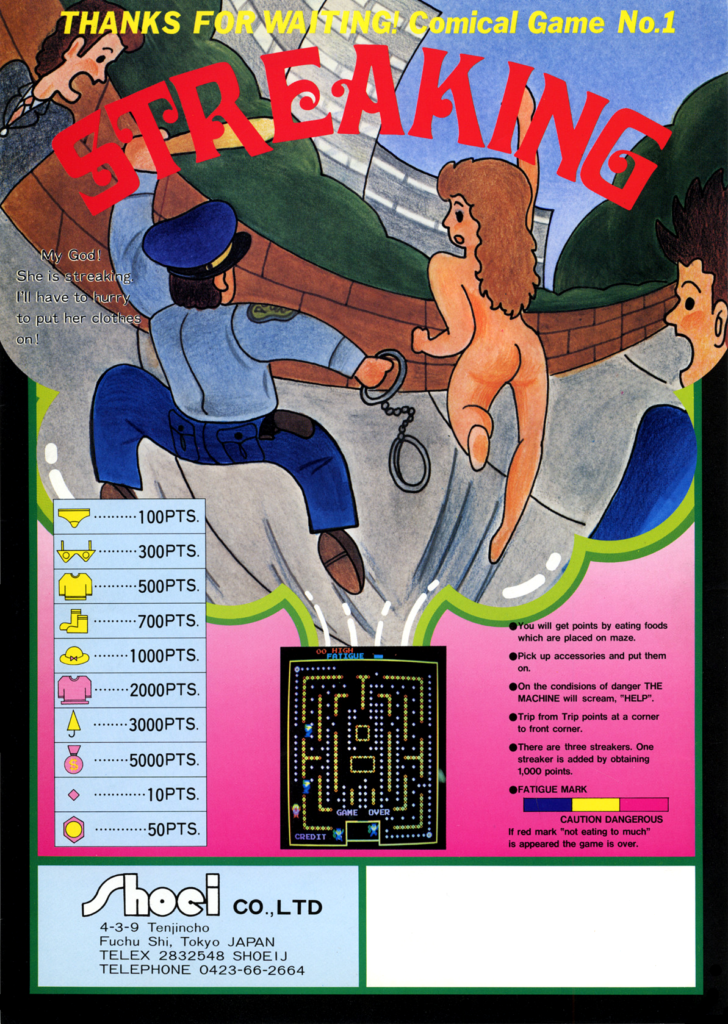
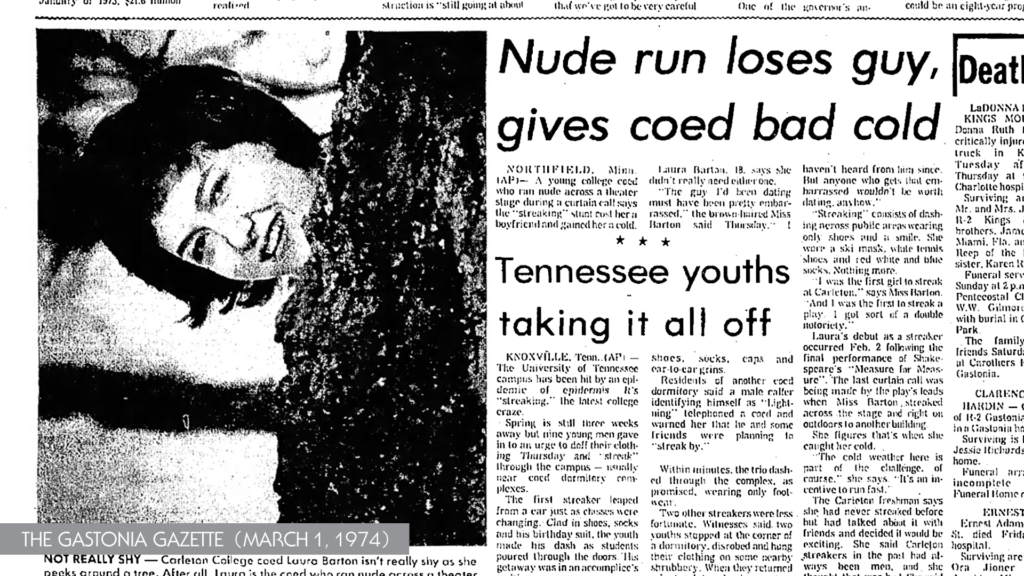
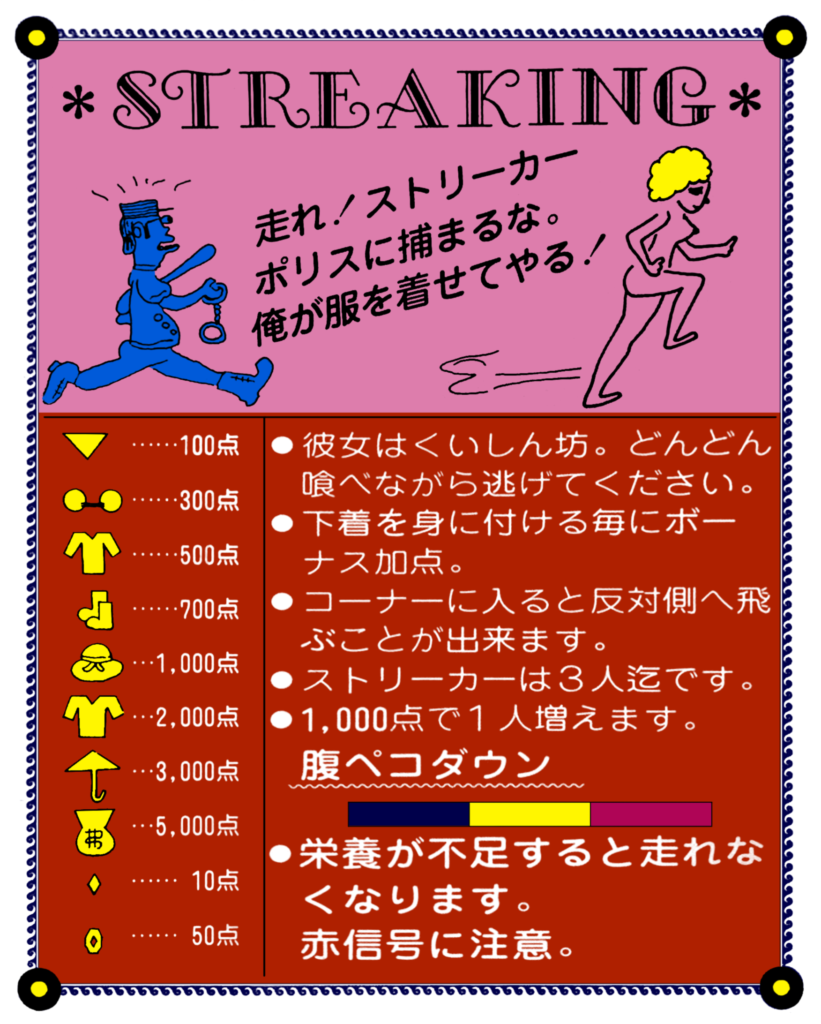

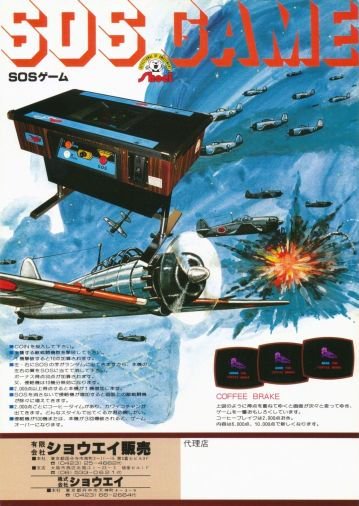
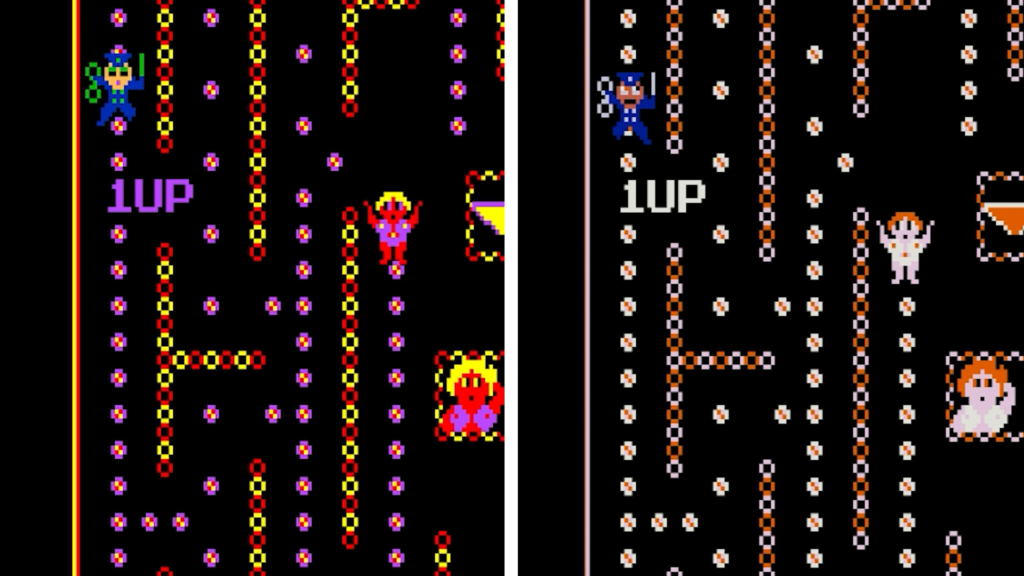
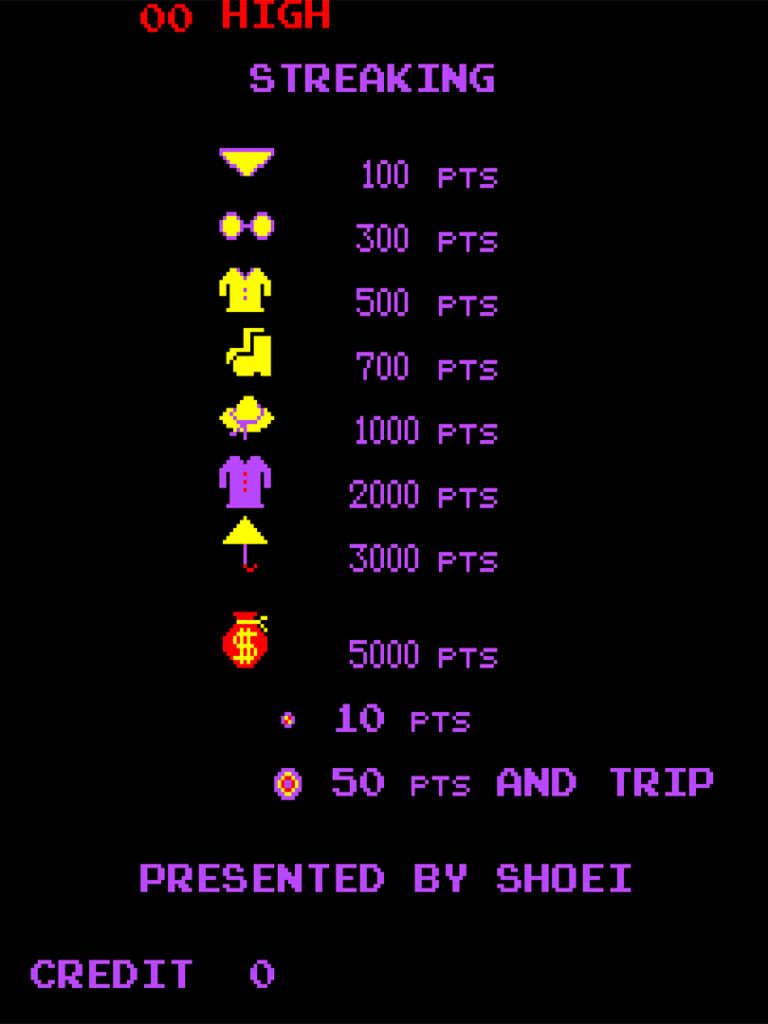
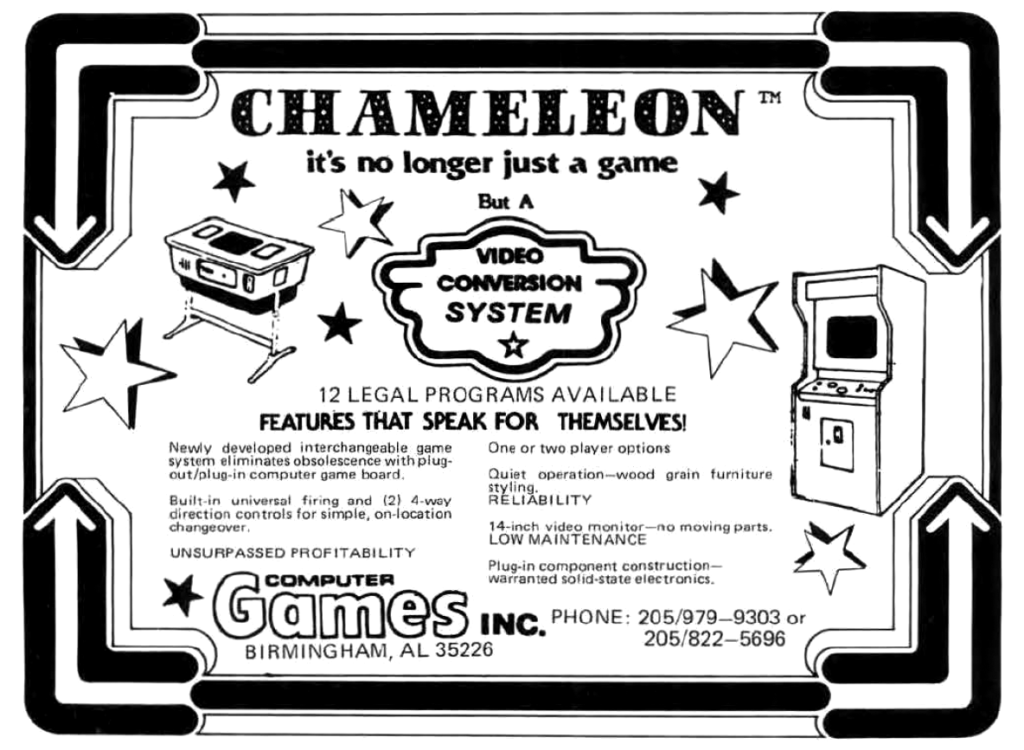


![An ad for "Streaker: The Hot One!!"
A description says "A cute nude girl tries to outrun a patrol of policeman [sic], points are gained by putting her clothing back on."](https://www.acriticalhit.com/wp-content/uploads/2021/08/ComputerGames-5-1024x750.png)
